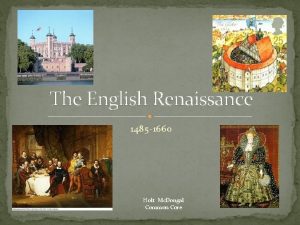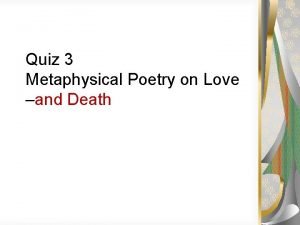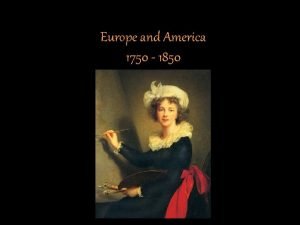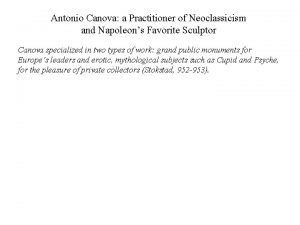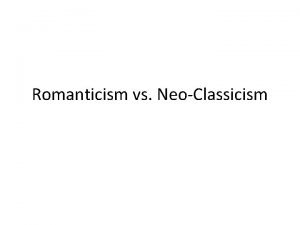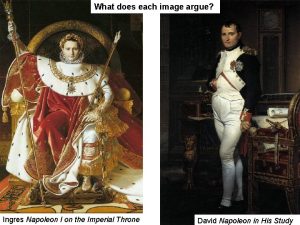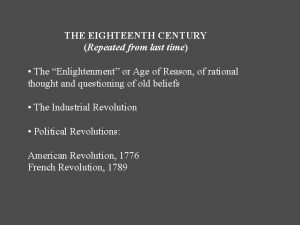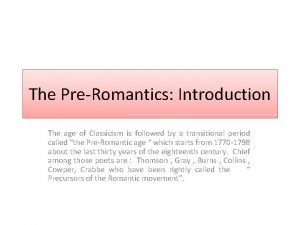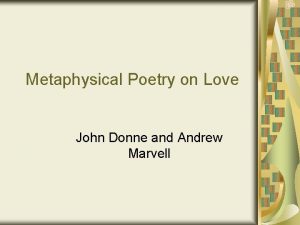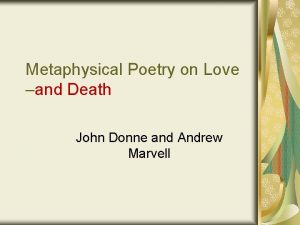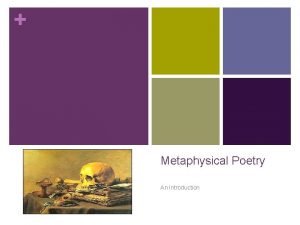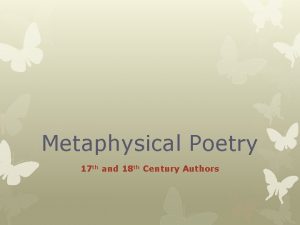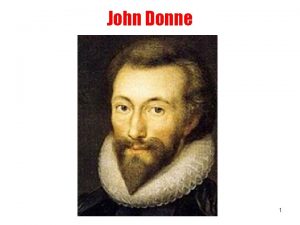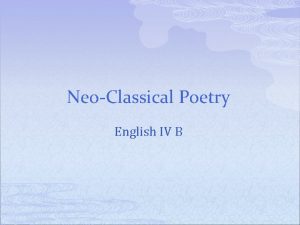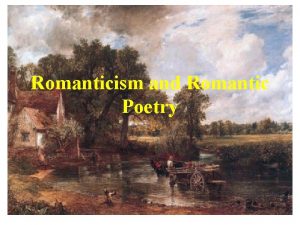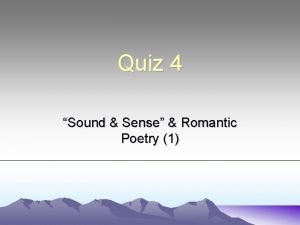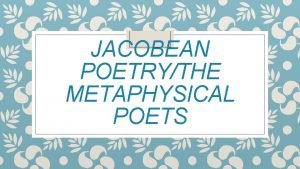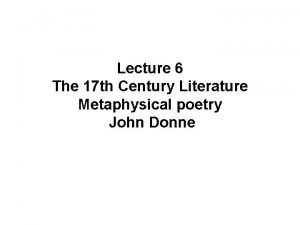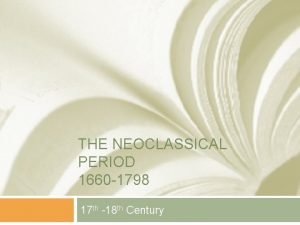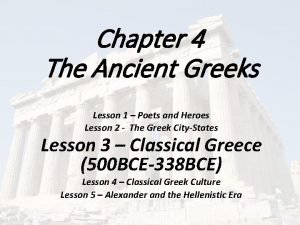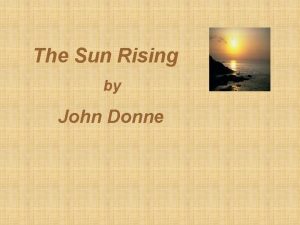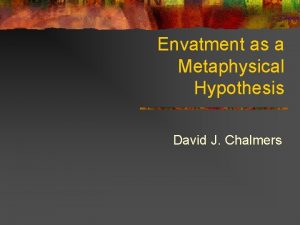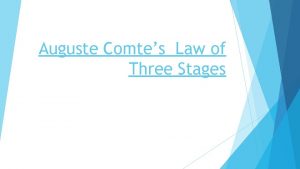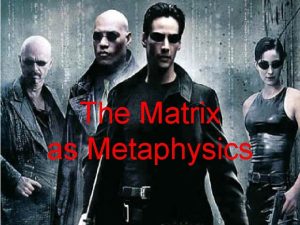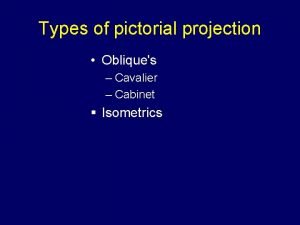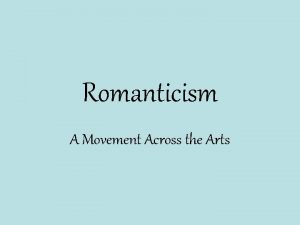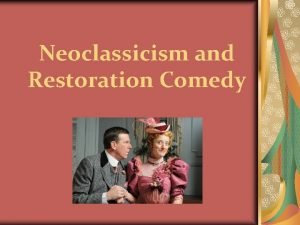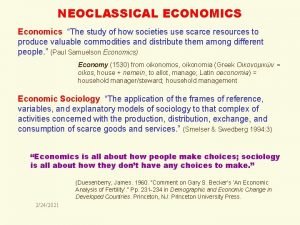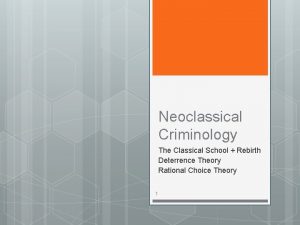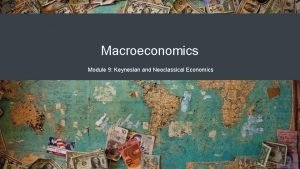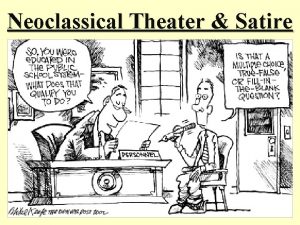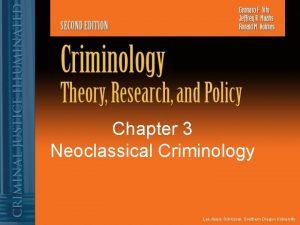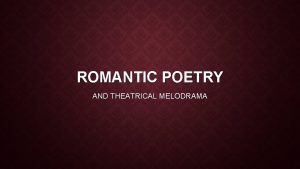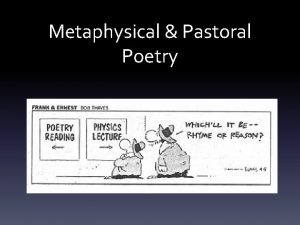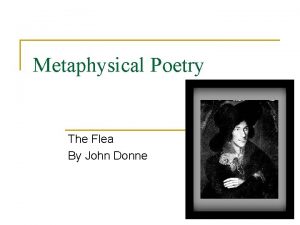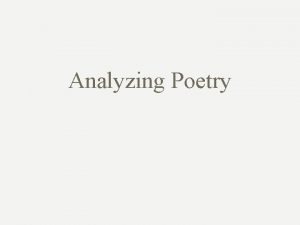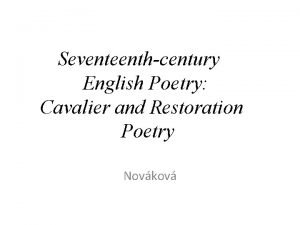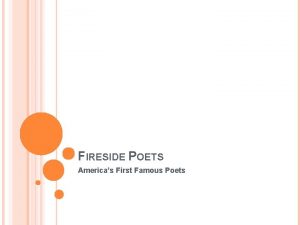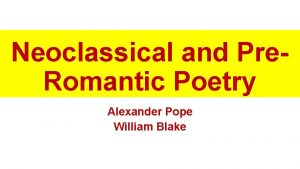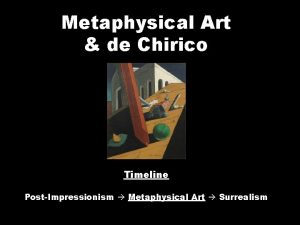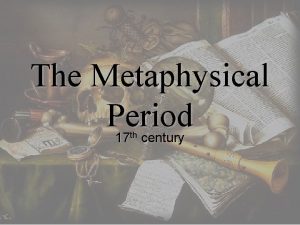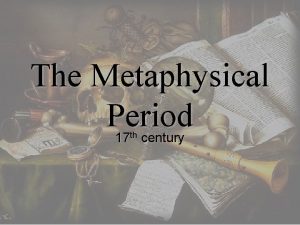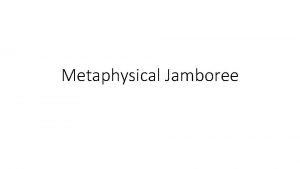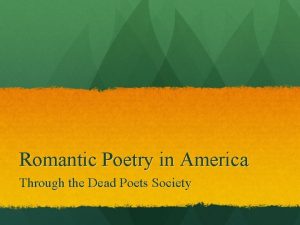POETRY THE CAVALIER METAPHYSICAL NEOCLASSICAL AND ROMANTIC POETS























































- Slides: 55

POETRY THE CAVALIER, METAPHYSICAL, NEOCLASSICAL, AND ROMANTIC POETS

METAPHYSICAL POETRY

HOW IS A HAMBURGER LIKE A BOOK?

HOW IS A HAMBURGER LIKE A BOOK? • Food for stomach • Food for thought • Hamburger cab be relished • Contents of book can be relished • Both have “covers” • Both have “contents” • Comparing a hamburger to a book is an example of a Metaphysical Conceit – a major characteristic of Metaphysical poetry

METAPHYSICAL POETRY • Early 17 th century • John Donne – leading poet Traits of a Metaphysical Poet: • Highly intelligent and cultured • Often held public careers in church, politics, academic world or court • Innovative, original • Appeals to the mind rather than to emotions

METAPHYSICAL POETRY • Forces us to follow an elaborate metaphor • Or a witty argument • Or a complex philosophical speculation • Instead of using flowing meters and harmonious images (as the Elizabethans did) • Metaphysical poets uses irregular, rhythm and unusual images

METAPHYSICAL CONCEITS • An elaborate metaphor or simile • Presents a more intellectual comparison • Cerebral figures of speech (more complex than just alliteration or foreshadowing) • Makes a comparison between two significantly different things

“A VALEDICTION FORBIDDING MOURNING” – JOHN DONNE • One of the most famous Metaphysical poems. • Contains one of the most famous conceits in all of English poetry Circumstances of writing the poem: • Donne addresses his wife in the poem. • He was about to leave to travel to France • He had forebodings about the separation • But, he was determined to stop the “tears” of parting by writing this valediction • Valediction: the action of saying farewell

TH 17 CENTURY VIEW OF THE UNIVERSE • The earth was the center of the universe • Around the earth in concentric spheres were situated the other heavenly bodies • God and the angels were in control of the entire system of being • People generally believed that all existence below the sphere of the moon (including the earth) was inferior. • Only in the heavenly spheres beyond the moon was there perfect existence.

• According to lines 1 -4, how do virtuous men die, and in contrast how to observers of dying men sometimes react? • Virtuous men due quietly • Observers dispute the moment of death • What kind of behavior mentioned I lines 1 -4 does the speaker in lines 5 -6 recommend he and his love do? • They should part as quietly as the virtuous die

• What, in lines 7 -8 would happen if the lovers cried out and told everyone about their love? • They would profane love • What is the difference between earthquakes and “trepidation of the spheres, ” as stated in lines 9 – 12? • Earthquakes are harmful; trepidation of the spheres is a greater but benign force. • When sublunary lovers are absent from each other, what does the absence cause to be removed, according to lines 13 -16? • The physical presence of the beloved.

• What attitude toward absence do such lovers feel? • Only pain and sorrow. • In contrast to the sublunary lovers of lines 13 – 16, what kind of love does the speaker clain he and his love shared (lines 17 -20)? • They share a more refined love. • Consequently, what happens to their souls upon parting, according to lines 21 -24? • The bond stretches but does not break

• Paraphrase the last 3 stanzas. Explain what happens to the two feet of a compass as one moves away and then returns. • The beloved is at the center, anchoring traveler’s path; it inclines toward him as he leaved and straighten as he returns. • What effect is achieved by the speaker’s associating himself and his love with the spheres in line 11? • The image suggests the higher nature of their love

• What is startling about the speaker’s comparing himself and his love to feet of a compass – why? What is appropriate about the image? • Compass is not the typical; romantic, delicate object usually associated with love, but works in this context; the compass’s actions mimic the lovers’ pattern, and this tool is used to map celestial orbits (symbol of world order). • Why should the parting of the lovers not be a cause for morning: what is true love, according to the poem? How persuasive is the speaker? • True lovers cannot really be parted a communion of souls • Very persuasive, committed to beliefs

• Therefore, poem is an intellectual approach to love; its complexity can distance the reader; ultimate impact is more intense than conventional love poetry • Poem is logical progression of thoughts and images; individual elements do not stand alone but work together to make a whole. • So … ties of true lovers do not break but stretch across distance beaten gold (treasured element, symbol of higher love), is malleable, yet taut (“beat” implies both the effort of stretching process and heartbeat, beat of love).

NEOCLASSICAL POETRY

NEOCLASSICAL POETRY (SOMETIMES KNOWN AS THE AUGUSTAN AGE OF ENGLISH) • Neoclassical poetry sprung from intellect, not from writers’ whims and imaginations. • It was a more moralizing, educational type of poetry as opposed to the romantic poetry of the Renaissance Period (14 th to 17 th century). The neoclassical period was predominantly in the 18 th and early 19 th century • Its main feature was rationalism (reason as the primary foundation and test of knowledge). • Neoclassical poets wrote poetry without calling on feelings and imagination to help them create their literary works • Major names of the neoclassical movement include Alexander Pope, and John Dryden

ALEXANDER POPE • “… born in London to a Roman Catholic family. A childhood sickness left him with stunted height, a curved spine, and ill health for the rest of his life. Pope earned fame and great financial success as a poet, satirist, and translator. He is perhaps best remembered for his mastery of the heroic couplet, as in An Essay on Man and “The Rape of the Lock. ”” (Poetryfoundation. org) • Heroic Couplet: traditional form for English poetry, commonly used in epic and narrative poetry, and consisting of a rhyming pair of lines in iambic pentameter. • Mock Epic: or heroi-comic works are typically satires or parodies that mock common Classical stereotypes of heroes and heroic literature. Typically, mock-heroic works either put a fool in the role of the hero or exaggerate the heroic qualities to such a point that they become absurd.

“THE RAPE OF THE LOCK” – CANTO I BY ALEXANDER POPE Context: “The inspiration for the poem was an actual incident among Pope’s acquaintances in which Robert, Lord Petre, cut off a lock of Arabella Fermor’s hair, and the young people’s families fell into strife as a result. John Caryll, another member of this same circle of prominent Roman Catholics, asked Pope to write a light poem that would put the episode into a humorous perspective and reconcile the two families” (Sparknotes). • Literature of the time was often morally and politically engaged. • Why does satire such as “The Rape of the Lock” serve as an ideal vessel for morally and politically engaged messages?

“THE RAPE OF THE LOCK” – CANTO I How does Pope establish the basis for a mock epic in the introductory stanza? He invokes the power of the Muse (in this case, the person who commissioned the poem, John Caryl) Who is Belinda? A beautiful, “coquette” of a woman who sleeps while her “guardian sylph” sends her a message via a dream. Coquette – 17 th century French word (later adapted for English vernacular) for a woman who flirts

What is a “sylph”? • A mythological creature (like a fairy or a sprite) that acts as a guardian angel for women. They are supposedly the spirits of women. “THE RAPE OF THE LOCK” – CANTO I Salamander – Fire There are four spirit types - each correlate to what the woman’s temperament was while she was alive on earth “To their first elements their souls retire: The sprites of fiery termagants in flame Nymph - Water Gnome - Earth Sylph – Air Mount up, and take a Salamander’s name. Soft yielding minds to water glide away, And sip with Nymphs, their elemental tea. The graver prude sinks downward to a Gnome, In search of mischief still on earth to roam. The light coquettes in Sylphs aloft repair, And sport and flitter in the fields of air. ” four spirits – four elements – four humors The Sylphs have an obvious vested interest in Belinda because she most closely resembles their own “light coquettish ideals”.

“THE RAPE OF THE LOCK” – CANTO I The discreet sexual charge of the poem leads us to the obvious conclusion that the Slyphs protect was particular aspect of Belinda’s life? (and the lives of women like her) Chastity What purpose does Ariel’s dream serve for Belinda? To warn “I saw, alas! Some dread event impend, ” “Warn’d by the Sylph, oh pious maid, beware! This to disclose is all thy guardian can. Beware of all, but most beware of man!”

“THE RAPE OF THE LOCK” – CANTO I Does Belinda heed Ariel’s warning? Billet-doux ( a humorous way of saying love letter) completely wipes away any sense of trepidation from Belinda’s mind. As Belinda continues about her day, she encounters her vanity (double meaning), filled with powders, pins, elixirs, and combs. What symbolic implications does this have? The vanity (as in a counter filled with personal hygiene products and the sense of excessive pride) - “Th’ inferior priestess, at her altar’s side” are filled with “sacred rites of pride” – sounds a lot like a religious ritual

“THE RAPE OF THE LOCK” – CANTO I • Belinda is not exactly Helen of Troy …. Pope is trying to make a point that while Belinda is attractive, she isn’t worth all of the trouble that is about to follow. This serves as a parallel to what Pope could be satirizing. He could be disenchanted with a government and policies (of which he is not a part because he is a Catholic) which focuses so much time on the petty and trivial – rather than important social issues. • Juxtaposes the petty and the grand (epic style of writing about something so silly) • Chastity and the “coquettes” – Pope makes an observation that women were groomed to be able to attract men while still being able to maintain their virtue. Hence, virginity was a tool for social mobility and not for moral aptitude.

CAVALIER POETS

CAVALIER POETS • Cavalier (adj) – showing a lack of proper concern; offhand • English – 17 th Century • The subject matter of Cavalier Poetry was different that of its predecessors which focused mostly on religion, philosophy, and the arts. Cavalier poets wrote about simple pleasures that gratified in the moment – beauty, love, nature, sensuality, fellowship, and camaraderie • You could say these poets were the original people to live by #YOLO. They simply referred to it in a different way … Carpe Diem

CAVALIER POETS • Carpe Diem – Latin, “seize the day” • This endorsement of living life to the fullest, for Cavalier writers, often included gaining material wealth and having sex with women. • These themes contributed to the triumphant and boisterous tone and attitude of the poetry. Platonic Love was also another characteristic of Cavalier poetry, where the man would show his divine love to a woman, where she would be worshipped as a creature of perfection. As such, it was common to hear praise of womanly virtues as though they were divine. • Significant authors include: Robert Herrick and Andrew Marvell

ROMANTIC POETRY

ROMANTICISM romantic (lower case r) • Hearts • Cupid • Dating/ Courting • Sexual Relations / Physical aspects of love • Valentine’s Day Romantic (Upper case R) • Romantics in the 1800’s stressed the examination of inner feelings , emotions, and the imagination. • Characteristics include longing for perfect love, a quest or journey, archetypal characters, utopian landscapes, nature , and romantic death

THE ROMANTIC ERA • AKA “The Romantic Era” / “Romantic Period” • Originated in the second half of the 18 th century Gained momentum in reaction to the industrial revolution • Effected the visual arts , poetry , literature, music , and even education and natural history • Basically, places an emphasis on the supernatural, heroes and villains, imagination • Significant poets include: William Blake, William Wordsworth, Samuel Taylor Coleridge, Lord George Gordon Byron, Percy Bysshe Shelley, John Keats

ROMANTIC ARCHETYPES • Archetype: the original model from which something is developed or made; in literary criticism, those images , figures, character types, settings, and story patterns that, according to the Swiss analytical psychologist Carl Jung, are universally shared by people across cultures • Reference the “Jungian Archetypes” Handout by Phillip Wedgeworth • Examine the two following video clips: • Which archetypes are represented within the two film clips?

WILLIAM BLAKE

WILLIAM BLAKE • “You say that I want somebody to elucidate my ideas. What is grand is necessarily obscure to weak men. That which can be made explicit to the idiot is not worthy of my care. The wisest of the ancients considered what is not too explicit as the fittest for instruction because it rouses the faculties to act. ” • not appreciated in his own day—later Romantics liked him • his genius was often called “madness”

WILLIAM BLAKE • Blake considered himself a mystic • Definition of mystic: one who believes it is possible to attain by FEELING & INTUITION, insight into spiritual mysteries beyond ordinary human knowledge; One who believes he attains union with God, the divine, or the universe.

WILLIAM BLAKE • Blake was aware always of a SPIRITUAL significance underlying the outward appearance of things. • --His method of understanding was IMAGINATION & INTUITION • --He believed in VISIONS—that truth came from visions. • --He said that “Imagination is spiritual sensation. ” As we know the physical world through our senses so then we know the world of the mind through sensations. • --He believed that he had “FOURFOLD VISION” and that spirits spoke through him. • --He had a deep reverence for the mysteries of nature and sees in nature reminders of God’s mysterious purposes.

WILLIAM BLAKE • Blake said that POETRY, PAINTING & MUSIC were the 3 powers in man that enabled him to “converse with Paradise” • --He was an artist all his life—maybe even more of an artist than a poet. And music was another of his talents—he often set his poems to music that he wrote. • --He said his task was “to open the immortal eye of man inwards into the worlds of thought. ”

WILLIAM BLAKE • --He was the prophet of the Romantic period • --Outstanding feature of Blake is his ability to explore both the NEGATIVE & POSITIVE aspects of the same subjects as he does in “Songs of Innocence/Experience, ” which is subtitled “The two contrary states of the human soul. ”

“THE RHIME OF THE ANCIENT MARINER” SAMUEL TAYLOR COLERIDGE

SAMUEL TAYLOR COLERIDGE • English poet, literary critic and philosopher and one of the founders of the Romantic Movement. • He is known mostly for his longer poem – “The Rhime of the Ancient Mariner” • His critical work, especially on Shakespeare, was highly influential, and he helped introduce German Idealist philosophy to English-speaking culture. • Coleridge coined the phrase “suspension of disbelief” (many other common phrases come from his poem “The Rhime of the Ancient Mariner” • He was a major influence on Emerson and American transcendentalism (remember? Thoreau and Walden Pond…)

SAMUEL TAYLOR COLERIDGE • Was in many ways the stereotype of the brooding, and emotional poet… • He suffered from depression and anxiety for most of his adult life and possibly from bipolar disorder as well • How do Coleridge’s emotional ailments only support his participation in the Romantic Movement?

“RHIME OF THE ANCIENT MARINER” • 2 primary themes: • Sin & redemption (crime, punishment, reconciliation) • The effects/consequences of a single unthinking act • The restorative powers of the imagination • Man’s attempt to understand the mystery surrounding the human soul in a universe moved by forces and powers at once immanent & transcendent

“RHIME OF THE ANCIENT MARINER” • Rhyme scheme alternates between ABAB and ABABAB • Odd lines – tetrameter (verse of four measures) • Even lines – trimeter (verse of three measures) • Does not always follow this pattern – is actually all over the place (in poetry we say “loose” rather than random” • Rhyming couplets • Archaic language – not indicative of the time • Narrative – tells a story • Lyric ballad – Lyrical, meaning it’s intended to invoke a sense of emotion and ballad meaning that it’s lengthy

PARTS I – IV Who are the major characters in this portion of the poem? Wedding Guest, Ancient Mariner, other sailors, Death, Life-In-Death What role does the weather play within the poem? The weather and water conditions are of obvious importance to the sailors on board: The ice cracks – they see the albatross The wind picks up – the albatross is shot Wind still blows – maybe it wasn’t the albatross after all? “Down dropped the breeze” – the sailors blame the Ancient Mariner “Idle as a painted ship Upon a painted ocean. ” – severe stillness in the water

THE ALBATROSS • A large sea bird. Meant to be a sign of good luck for sailors. • For our interpretive purposes, a metaphor for a psychological burden that feels like a curse that can be hard to unload

PARTS I – IV “Water, water, every where, Nor any drop to drink. ” A statue of the ancient mariner with the albatross around his neck, at Watchet, Somerset. "Ah ! well a-day ! what evil looks Had I from old and young! Instead of the cross, the Albatross About my neck was hung. "

PARTS I – IV • Sin and redemption – Map the process of redemption throughout the first portion of the poem (Crime, punishment, redemption) – Crime: • “With my crossbow, I shot the Albatross. ” – Punishment: • “Instead of the cross, the Albatross, About my neck was hung. ” • “Alone, all, all alone, Alone on a wide, wide sea! And never a saint took pity on My soul in agony. ” • “The many men, so beautiful! And they all dead did lie: And a thousand slimy things Lived on; and so did I. ” • “The souls did from their bodies fly, - They fled to bliss or woe! And every soul it passed me by, Like the whizz of my crossbow!”

PARTS I – IV • Redemption: “O happy living things! no tongue Their beauty might declare: A spring of love gush’d from my heart, And I bless’d them unaware: Sure my kind saint took pity on me, And I bles’d them unaware. The selfsame moment I could pray; And from my neck so free The Albatross fell off, and sank Like lead into the sea. ”

PARTS I – IV • The ocean – represents the mysteries of the human soul and the unconscious. – Just like the sea, an individual's personality is often like a flat, uniform surface that conceals a deepness filled with those bizarre and often unsightly creatures we call emotions or desires. – So, when the Mariner pollutes his soul by killing the albatross, it's not a surprise to see that the ocean becomes polluted with slime and horrible creatures. – The imagery of the vast, vacant ocean, particularly once the rest of the crew has died, expresses a condition of spiritual solitude and loneliness.

PARTS I-IV • Rotting, death, decay – The ocean seems to rot with slimy things infesting its waters • After the crew dies, their bodies do not decay I look’d upon the rotting sea, And drew my eyes away; I look’d upon the rotting deck, And there the dead men lay. …. . I look’d to heaven, and tried to pray; The cold sweat melted from their limbs, Nor rot nor reek did they: The look with which they look’d on me Had never pass’d away. • It is as though the dead men continue to curse the mariner with their stares

PARTS I – IV Supernatural Elements • Death and his mate, Life-in-death (what does she look like? ) • What game do they play? • Who wins? • What happens after the win?

PARTS I – IV Supernatural Elements • Death and his mate, Life-in-death (what does she look like? ) – Gold hair, “skin as white as leprosy”, and red lips • What game do they play? – Dice • Who wins? – Life – in death • What happens after the win? – The crew dies off and their souls flee as the moon rises – The sea turns a variety of colors after the mariner is able to pray “Within the shadow of the ship I watched their rich attire: Blue, glossy green, and velvet black, They coiled and swam and every track Was a flash of golden fire”

“THE RHIME OF THE ANCIENT MARINER” PARTS V – VII

PARTS V - VII Transition from parched, dry state to a dewy, wet condition: “My lips were wet, my throat was cold, My garments all were dank; Sure I had drunken in my dreams. And still my body drank” What is the mariner able to do now that he has prayed? Sleep

PARTS V – VII • How are the elements of the supernatural revisited in these sections? – The crew rises from the dead like zombies – The crew transforms into “seraphs” (figures made of light) – The wind and the ocean engage in a tug-o-war over the ship, which is eventually sunk: “The Devil knows how to row. ” – the boy exclaims in his fear

PARTS V – VII • What does the mariner believe will happen if he can encounter the hermit? • “O shrieve, me shrieve, holy man!” - he believes the holy Hermit can absolve him of his “sins” • What was the lesson imparted upon the wedding guest? “Farewell, farewell! But this I tell To thee, thou Wedding-Guest! He prayeth well, who loveth well Both man and bird and beast. He prayeth best, who lovest best All things both great and small; For the dear God who loveth us, He made and loveth all. ”
 Neoclassical and romantic poetry
Neoclassical and romantic poetry Batter my heart mcq
Batter my heart mcq Metaphysical poets focused on _____.
Metaphysical poets focused on _____. Which of the following is wrong about metaphysical poets
Which of the following is wrong about metaphysical poets Neoclassical poets
Neoclassical poets Explain romanticism
Explain romanticism The apotheosis of homer
The apotheosis of homer Napoleon crossing the alps neoclassical or romantic
Napoleon crossing the alps neoclassical or romantic Canova neoclassical or romantic
Canova neoclassical or romantic Charles barry romanticism
Charles barry romanticism Napoleon ingres
Napoleon ingres Third of may 1808
Third of may 1808 Pre romantic poetry characteristics
Pre romantic poetry characteristics Second generation romantic poets
Second generation romantic poets Fireside poets characteristics
Fireside poets characteristics British romanticism characteristics
British romanticism characteristics Augustan age and romanticism
Augustan age and romanticism Metaphysical poetry
Metaphysical poetry John donne carpe diem
John donne carpe diem Introduction to metaphysical poetry
Introduction to metaphysical poetry Metaphysical poetry characteristics
Metaphysical poetry characteristics John donne as metaphysical poet
John donne as metaphysical poet Metaphysical poetry characteristics
Metaphysical poetry characteristics Neoclassical poetry
Neoclassical poetry Features of romantic age
Features of romantic age Romantic era poetry characteristics
Romantic era poetry characteristics Romantic poetry characteristics
Romantic poetry characteristics Romantic poetry quiz
Romantic poetry quiz Jacobean priest and metaphysical poet
Jacobean priest and metaphysical poet Go and catch a falling star as a metaphysical poem
Go and catch a falling star as a metaphysical poem Neoclassical organization theory
Neoclassical organization theory Father of modern criminology
Father of modern criminology Key principles of classical and neoclassical criminology
Key principles of classical and neoclassical criminology Neoclassical period in english literature
Neoclassical period in english literature Famous ukrainian authors
Famous ukrainian authors Chapter 4 lesson 1 poets and heroes
Chapter 4 lesson 1 poets and heroes The sun rising john donne
The sun rising john donne Brain in a vat
Brain in a vat Law of three stages auguste comte
Law of three stages auguste comte Metaphysical hypothesis examples
Metaphysical hypothesis examples Caroline poetry
Caroline poetry John donne as a metaphysical poet
John donne as a metaphysical poet John donne as a metaphysical poet
John donne as a metaphysical poet Famous narrative poems
Famous narrative poems Receding axis
Receding axis Enlightenment vs romanticism
Enlightenment vs romanticism Characteristics neoclassical art
Characteristics neoclassical art Comedy of manners definition in literature
Comedy of manners definition in literature Neoclassical economics
Neoclassical economics Neoclassical criminology
Neoclassical criminology Neoclassical
Neoclassical Neoclassical economics examples
Neoclassical economics examples Neoclassical satire
Neoclassical satire Neoclassical french theatre
Neoclassical french theatre Neoclassical theory of crime
Neoclassical theory of crime Neoclassical growth theory vs. endogenous growth theory
Neoclassical growth theory vs. endogenous growth theory


